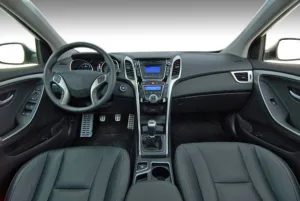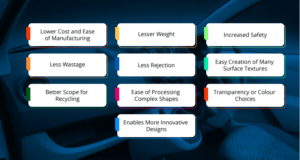The automotive industry is using more and more plastic materials. According to some statistics, plastic accounts for up to 50% of the volume but only 10% of the weight of modern automobiles. Therefore, it would have been unexpected if design engineers had overlooked the possibility of using plastics to reduce weight and cost. The Corporate Average Fuel Economy (CAFE) standard, which increased vehicle fuel efficiency, was a major factor in the United States of America’s growing use of plastics in automobiles.
Plastic has become increasingly popular among automakers for use in numerous automotive components. For someone to work for an automotive manufacturer or a company that manufactures plastic components, knowledge of plastic components and their manufacturing has become essential.
Let’s attempt to learn a little bit more about the production process of these plastic components.

Reasons to use Plastic/Polymers in automotive
Many automotive parts were composed of metal, glass, wood, etc. in the past. They are now composed of plastic. These are the causes.

Lower Cost and Ease of manufacturing
It only takes a few steps to manufacture plastic components. In contrast to other materials like metal, the majority of the components only need a few steps to complete. Because they require fewer machines and require less time to produce, they can be produced at a lower cost.
Lesser Weight
When compared to other materials, plastic components are thinner on the walls and have a lower density. As a result, these components weigh a lot less. And this is a very important factor in the manufacture of cars as well as ships and aeroplanes.
Increased Safety
Polymers and plastic are essential for improving vehicle safety. Examples include airbags, seat belts, and the thin plastic layer that forms windscreens by sandwiching it between two layers of glass. Polymer bumpers, for example, have the ability to absorb four to five times more energy during an impact than any other alternative material.
Less Wastage
When plastic components, for example, are machined, very little waste material is produced.
Less rejection
When compared to other manufacturing processes like sand casting and machining, plastic processing is far more reliable. There is less likelihood of rejection here.
Easy creation of many Surface Textures
After being manufactured, the metal components usually require surface treatment. Such independent surface treatment procedures are not necessary for plastic components. One can obtain a plain surface or textured surfaces, such as hammer tone, wrinkled, non-gloss, and leather surface textures, in the main process itself. Learn more

